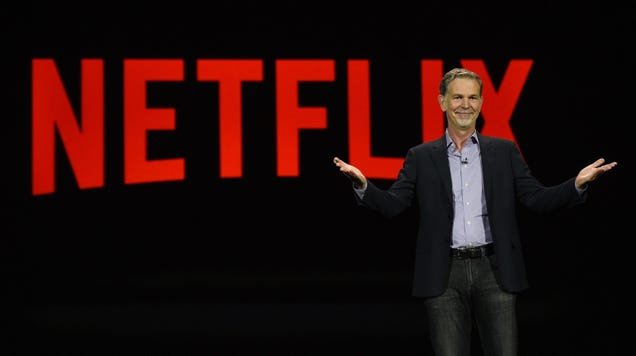Netflix’s co-founder and chief stole the show from a surprise uptick in subscriptions.
The streaming giant posted bumper earnings yesterday (Jan. 19), adding a net 7.7 million new subscribers—way more than the 4.5 million it had projected. But that news wasn’t the day’s headline item, as it was overshadowed by Reed Hastings announcing he’d step down as CEO after 25 years.
Content chief Ted Sarandos, who was named Hastings’ co-CEO in 2020, will continue in his role. Greg Peters, previously chief product officer and chief operating officer, joins Sarandos as co-CEO.
“Ted, Greg and I have been working closely together in different capacities for 15 years,” Hastings wrote in his statement. “As is common in long, effective relationships, we’ve all learned how to bring out the best in each other. I look forward to working with them in this role for many years to come.”
While other entertainment giants like Disney are bringing back old guards and getting embroiled in a war of words with disgruntled activist investors over leadership, Netflix has gone down a more calculated and meticulous route. The change of hands has been at least two years in the making—well before the Netflix stock began cratering and the company struggled to maintain subscription momentum.
Quotable: Planning for succession
“Our board has been discussing succession planning for many years (even founders need to evolve!). As part of that process, we promoted Ted to co-CEO alongside me in July 2020, and Greg to Chief Operating Officer—and in the last 2½ years I’ve increasingly delegated the management of Netflix to them.
It was a baptism by fire, given covid and recent challenges within our business. But they’ve both managed incredibly well, ensuring Netflix continues to improve and developing a clear path to reaccelerate our revenue and earnings growth. So the board and I believe it’s the right time to complete my succession.” —Reed Hastings
Do Co-CEO arrangements work?
At its worst, the co-CEO model lends itself to disagreements and ego clashes. But when it works, it could lead to better collaboration, a breadth of skill sets, and considered decision-making.
In his note, Hastings credited Sarandos with having the “early foresight and skill to push into original programming” and to “expand into international originals, film, animation, and unscripted.” Hastings also praised Peters for his contribution in forging partnerships, building advertising, honing personalization, strengthening the culture, and most recently, building out Netflix’s games initiative.
Albeit rare, there are instances where companies have two leaders. Australian software company Atlassian’s co-CEOs have worked side-by-side for 20 years. But then, there are also examples of it being an arrangement that runs its course. Chipotle had two CEOs for seven years until it went back to one in 2016 after a year marked by crises caused sales and the stock to plummet. Workday, the HR software giant that has had a two-CEO arrangement in 2020, is looking to move away from it by next year.
At Netflix, Hastings said the two new co-CEOs have “developed great trust and respect for each other” and they’ll “put Netflix’s interests first.”
Money matters, by the digits
$34 million to around $3 million: How much of a pay cut Hastings is expected to take in stepping down as co-CEO
44%: The hike Peters may see in his annual compensation package, which previously stood at $24 million
Other people of interest: Bela Bajaria and Scott Stuber
There has been some more reshuffling among the top brass:
- Bela Bajaria, formerly head of global TV, has been promoted to chief content officer
- Scott Stuber, the head of global films, is now chairman of Netflix Film
What’s next for Reed Hastings?
Hastings remains executive chairman of the board, and he will continue working with Sarandos and Peters.
However, if he chooses to go down a different, new route, there’s someone who’s offered to join him: his Netflix co-founder Marc Randolph, who stepped down as CEO in 1999 and left the company in 2003—four years before it started streaming movies.
Fun fact: The “Blockbuster” reason behind Netflix’s success
In 1997, 36-year-old Reed Hastings founded Netflix out of frustration—Blockbuster had charged him an obscene $40 fee for returning his Apollo 13 DVD late. At his company, subscribers could order DVDs online (no more than three a month), get them in the mail, and keep them for as long as they like without any late fees.
With rentals fueled by personalized recommendations—something Blockbuster couldn’t do for its massive user base—Netflix carved a space for itself. But soon, competition from behemoths like Walmart replicating its model at lower prices surfaced as a threat.
In 2000, Hastings gave Blockbuster the offer to buy his video-rental company for $50 million but the bigger video-rental company laughed it off. Today, Netflix is a $140 billion company, while Blockbuster is trying to claw its way out of the grave.
👐 Netflix’s earnings won’t yet show the full impact of the new $6.99 ad-supported subscription
🧑🤝🧑 How did Netflix lose subscribers in 2022?
📺 Twenty years ago, Netflix.com launched. The movie business has never been the same.








